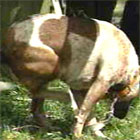25% of pets are affected by allergies, which can make their lives uncomfortable and miserable. Dr. Chris Brown discussed why pets get allergies and how best to prevent and treat them.
Environmental allergens:
Pets can become ‘hypersensitive’ to a substance they encounter in the environment. They may not initially have any sensitivity to it at all but in time the body may ‘over react’ when it comes into contact with a substance and produce an allergic reaction. This can happen in two ways:
1. Inhalation of pollen and plant material from weeds (ragweed, sorrel, dock), trees (privet, oak, pine, birch) and grasses (couch, paspalum and fescue)
2. Direct contact with grass and plants such as wandering jew, clover and kikuyu
Flea allergy dermatitis:
The most common cause of allergies in pets is fleas, although most owners swear their pets don’t have them. The signs of a flea infestation include flaky red skin and little flecks of flea dirt (poo), usually in the area just above the tail. If you run a flea comb through your pet’s coat you’ll soon pick up a few fleas. Or try the paper test: wet an A4 sheet of white paper. Hold the paper next to your pet’s rump (where fleas love to congregate). Ruffle the fur so that bits of dirt from the coat fall onto the wet paper. Streaks of red (wet flea poo) are tell-tale signs that fleas are present.
Symptoms:
Symptoms of allergies include a red rash and an itchy face, body, feet or ears. Recurrent skin or ear infections may occur, as well as conjunctivitis. Anal glands can also be inflamed. Allergies are seen more in dogs than cats. Licking and chewing of feet and paws are common ‘giveaway’ signs. Dogs from six months to 4 years old are commonly affected, and short-haired breeds are more susceptible, because it is easier for the allergens to come in contact with the skin. The top 5 breeds on the ‘Itch List’ are:
1. West Highland White Terrier
2. Irish Setter
3. Sharpei
4. Maltese
5. Staffordshire Bull Terrier
Bulldogs, Spaniels, Dalmatians, Labradors and Golden Retrievers are also commonly affected.
Treatment:
After the skin becomes inflamed your dog is likely to get a secondary infection, because bacteria will find it easier to breed. Your vet may do a skin test or take a blood test to determine the cause of the allergy, and then give cortisone and antibiotics to remove the itch and control the infection. If fleas are present, controls such as top spots for the dog and flea bombs for its environment may be necessary.
You can reduce the animal’s exposure to allergens by bathing the pet with a medicated or soothing wash, such as Malaseb or Aloveen. Remove wandering jew from the backyard, and avoid walking your dog in areas where grasses such as paspalum are seeding.
Diets containing omega 3 will also help control allergies. Most premium dog foods now have omega 3 oils added. The extra oils in the skin provide an extra barrier to allergens breaking through the skin surface, and also act as a natural anti-inflammatory to lessen allergic reactions in the body.
Further information
Top-spots such as Frontline, Advantage and Revolution start from around $30 for a three month supply. Available from Veterinarians.
Flea Bombs cost from $11.00 for a pack of two. Available from supermarkets.
Flea combs are available from clinics and pet stores from $7.
Blood tests for dogs (includes hyposensitation vaccine) cost about $400.



